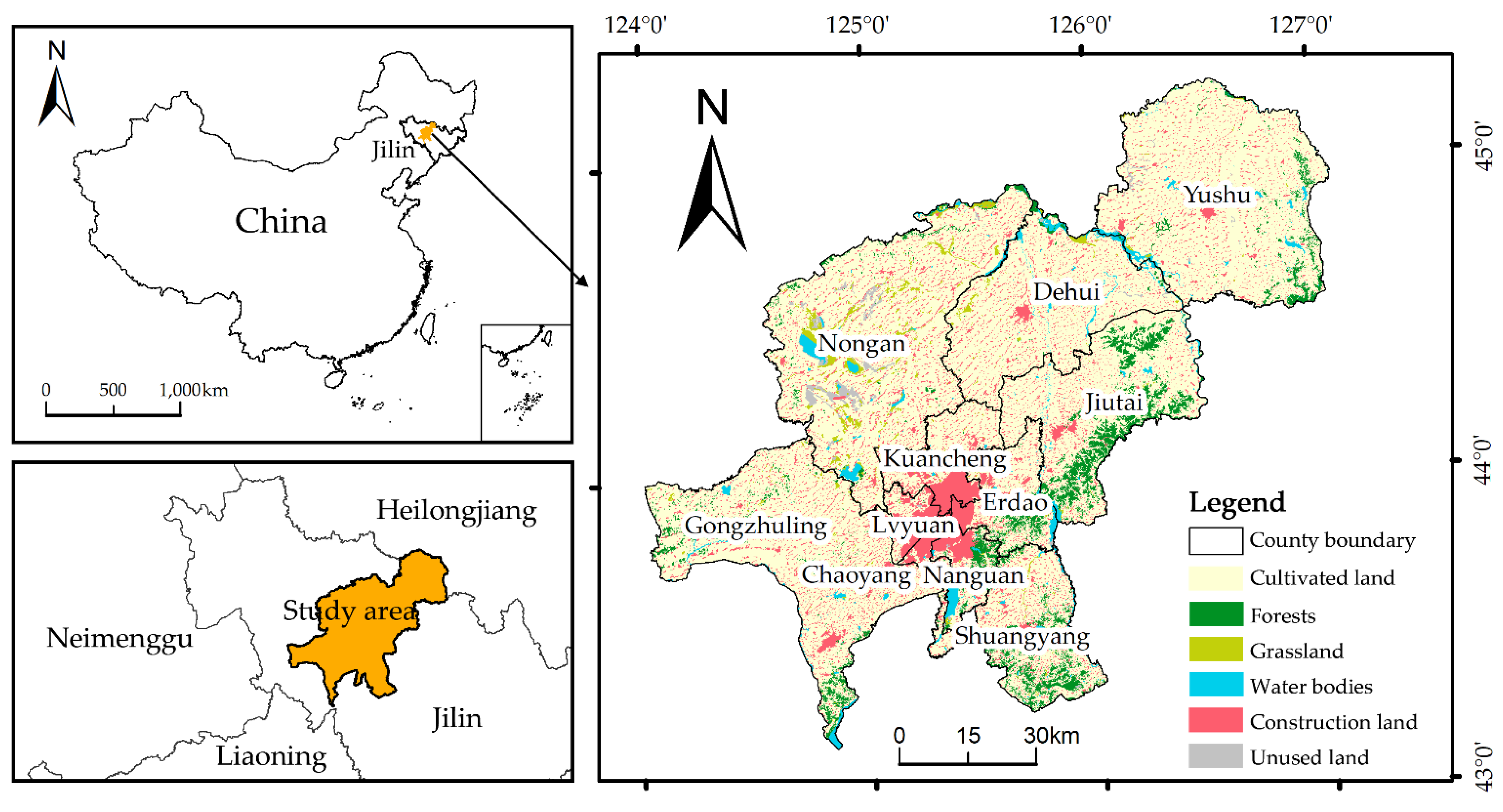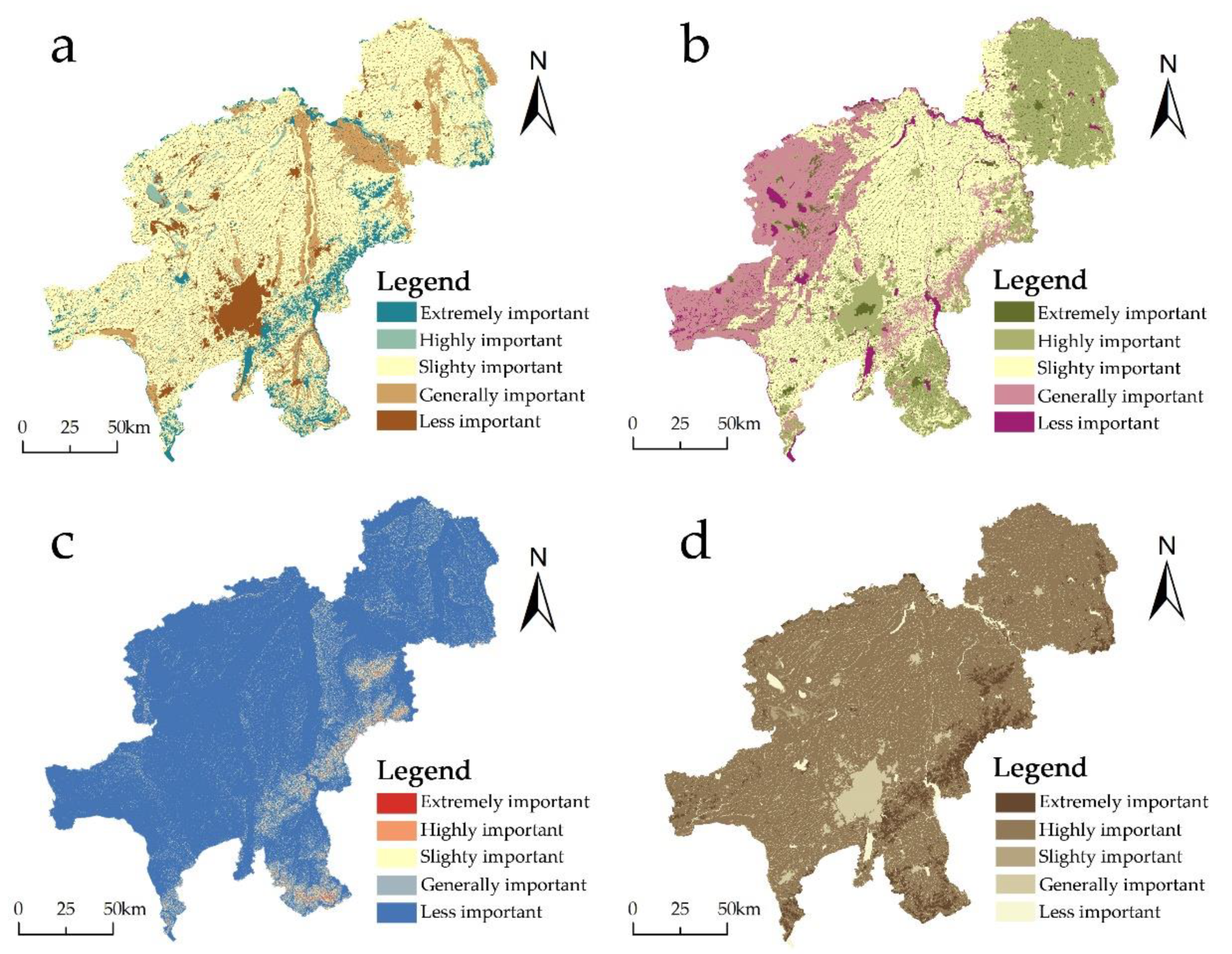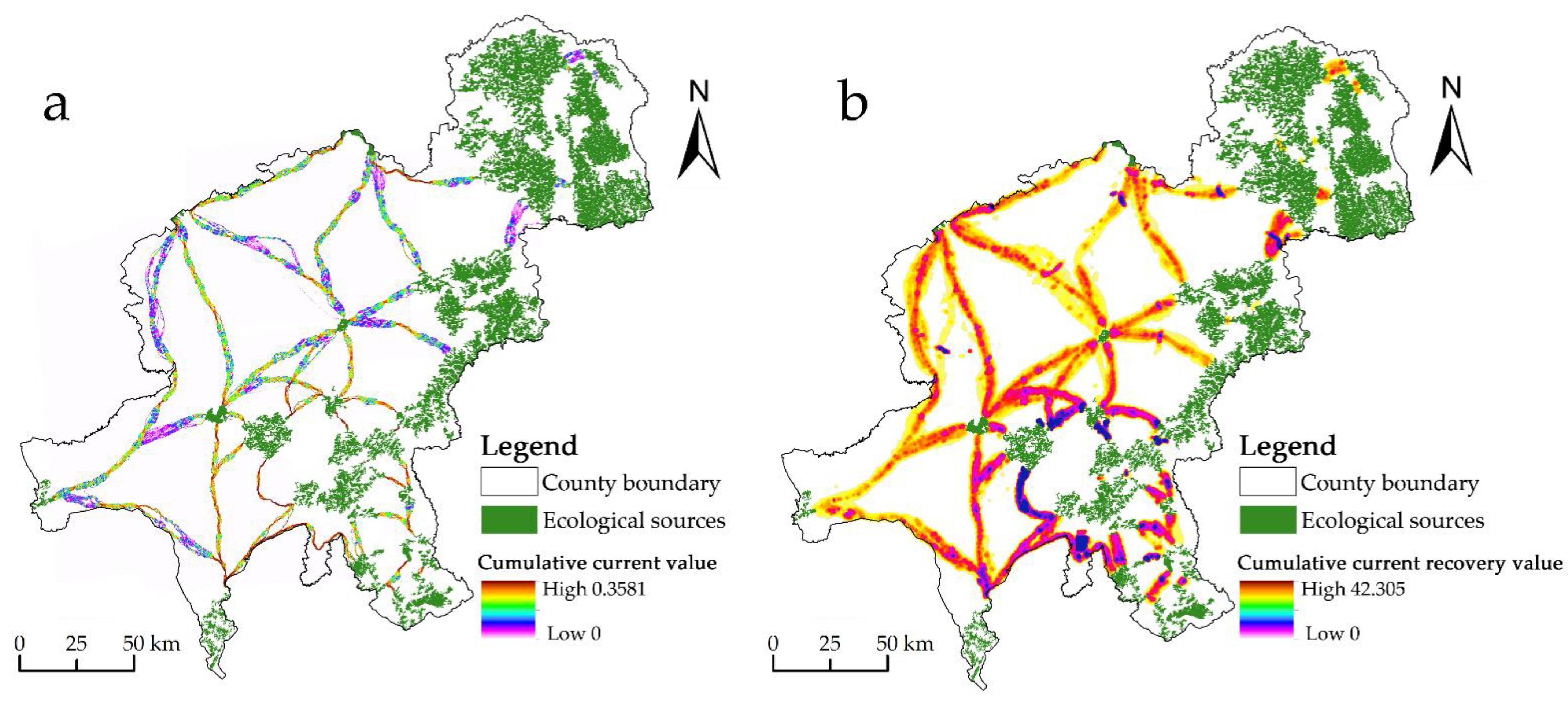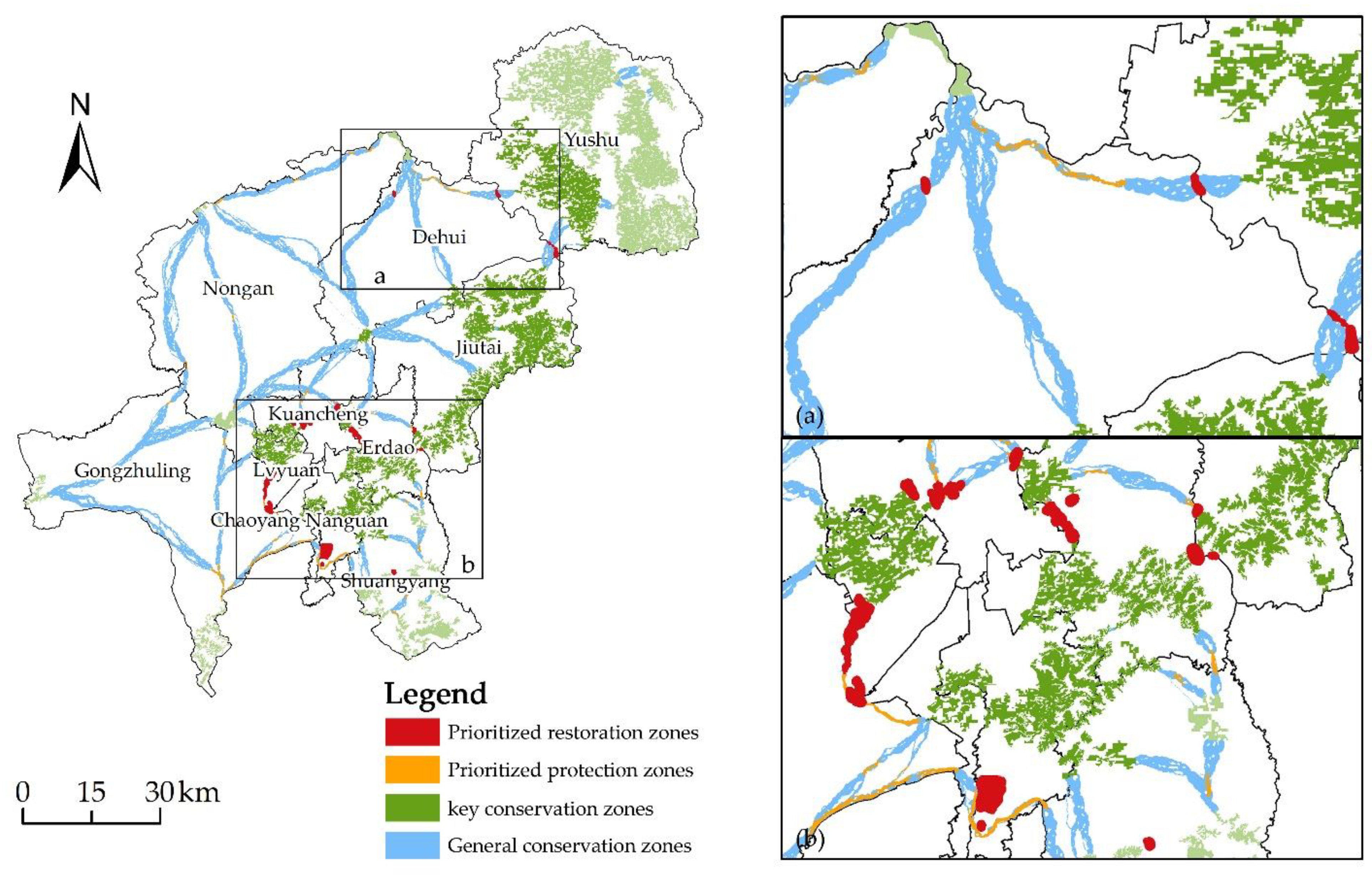Construction of Ecological Security Pattern and Identification of Ecological Restoration Zones in the City of Changchun, China
Abstract
1. Introduction
2. Materials and Methods
2.1. Study Area
2.2. Data Sources and Pre-Processing
2.3. Methods
2.3.1. Evaluation of the Importance of Ecosystem Service Functions
- 1.
- Functional evaluation of biodiversity
- 2.
- Evaluation of water supply function
- 3.
- Evaluation of soil conservation function
- 4.
- Functional evaluation of carbon stock
2.3.2. The Identification of Ecological Sources
2.3.3. The Construction of Basic Resistance Surface
2.3.4. Constructing Ecological Restoration Zones
3. Results
3.1. Source Identification Based on the Importance of Ecosystem Services
3.2. Construction of Resistance Surface
3.3. Corridor Extraction and Ecological Node Identification
3.4. The Construction of Ecological Restoration Zones
4. Discussion
4.1. Spatial Heterogeneity of Ecosystem Services
4.2. Ecological Protection and Restoration
4.3. Research Strengths and Limitations
5. Conclusions
- (1)
- The importance of spatial heterogeneity in ecosystem services including biodiversity conservation, water production, soil conservation, and carbon fixation in Changchun is obvious. There are 4698.92 km2 of extremely important areas, accounting for 18.99% of the total city area. These areas are primarily located in the city’s eastern region and are dominated by cultivated land and forests. Among these, Yushu City, the eastern portion of Jiutai District and Erdao District, and the northern portion of Shuangyang District are relatively heavily populated. Through ecological service evaluation and area rationalization allocation, the study identifies 20 ecological source regions with a total area of 3659.28 km2, representing 14.79% of ecological land.
- (2)
- The natural resistance surface is rectified using nighttime light intensity data to create an all-encompassing resistance surface. The results indicate that the principal urban region has higher resistance, indicating a propensity for dispersal and that the settlement centers of each county also have higher resistance. Linkage Mapper extracted the lowest cost paths to build ecological corridors, establishing 41 major ecological corridors in the city to form a somewhat dense mesh structure in the south. The centrality of ecological sources was determined, showing that the biggest concentration of ecological sources accumulated in the second channel area and required significant protection. Moreover, 15 ecological barriers and 31 ecological pinch points were identified to guide ecological security pattern conservation and restoration.
- (3)
- The ecological restoration areas were identified, in which prioritized restoration zones consisted of ecological corridor barriers, mostly in the main urban area of Changchun and the urban fringe, which needed to be restored to ensure the flow of materials and energy transport. Prioritized protection zones are located in a small section of the ecological corridor, including Yushu City and Gongchuling City, where urban development must be minimized. Key conservation zones are the core areas of ecological sources with high-centeredness and ecological radiation benefits to the surrounding areas, primarily in the eastern portion of the city. These key areas must be conserved to preserve the circulation of ecological corridors. The general conservation zone contains critical corridors with width information and requires appropriate protection measures to preserve the entire ecological security pattern and enhance overall performance of the ecosystem service.
Author Contributions
Funding
Institutional Review Board Statement
Informed Consent Statement
Data Availability Statement
Acknowledgments
Conflicts of Interest
References
- Di Giulio, M.; Holderegger, R.; Tobias, S. Effects of Habitat and Landscape Fragmentation on Humans and Biodiversity in Densely Populated Landscapes. J. Environ. Manag. 2009, 90, 2959–2968. [Google Scholar] [CrossRef]
- Solow, A.R. On Detecting Ecological Impacts of Extreme Climate Events and Why It Matters. Philos. Trans. R. Soc. B Biol. Sci. 2017, 372, 20160136. [Google Scholar] [CrossRef] [PubMed]
- Tutak, M.; Brodny, J.; Bindzár, P. Assessing the Level of Energy and Climate Sustainability in the European Union Countries in the Context of the European Green Deal Strategy and Agenda 2030. Energies 2021, 14, 1767. [Google Scholar] [CrossRef]
- Zhang, J.; Cao, Y.; Ding, F.; Wu, J.; Chang, I.-S. Regional Ecological Security Pattern Construction Based on Ecological Barriers: A Case Study of the Bohai Bay Terrestrial Ecosystem. Sustainability 2022, 14, 5384. [Google Scholar] [CrossRef]
- Dai, L.; Liu, Y.; Luo, X. Integrating the MCR and DOI Models to Construct an Ecological Security Network for the Urban Agglomeration around Poyang Lake, China. Sci. Total Environ. 2021, 754, 141868. [Google Scholar] [CrossRef]
- Gonzalez, A.; Rayfield, B.; Lindo, Z. The Disentangled Bank: How Loss of Habitat Fragments and Disassembles Ecological Networks. Am. J. Bot. 2011, 98, 503–516. [Google Scholar] [CrossRef]
- Rao, Y.; Dai, J.; Dai, D.; He, Q.; Wang, H. Effect of Compactness of Urban Growth on Regional Landscape Ecological Security. Land 2021, 10, 848. [Google Scholar] [CrossRef]
- Zhang, Y.; Li, S.; Yan, J. Spatiotemporal Variation of Urban Ecological Security and Its Influencing Factors in North and South of Qinling-Huaihe Region, China. Resour. Environ. Yangtze Basin 2021, 30, 2736–2745. (In Chinese) [Google Scholar]
- Zhao, Y.; Kasimu, A.; Liang, H.; Reheman, R. Construction and Restoration of Landscape Ecological Network in Urumqi City Based on Landscape Ecological Risk Assessment. Sustainability 2022, 14, 8154. [Google Scholar] [CrossRef]
- Li, J.; Xu, J.; Chu, J. The Construction of a Regional Ecological Security Pattern Based on Circuit Theory. Sustainability 2019, 11, 6343. [Google Scholar] [CrossRef]
- Gao, J.; Du, F.; Zuo, L.; Jiang, Y. Integrating Ecosystem Services and Rocky Desertification into Identification of Karst Ecological Security Pattern. Landsc. Ecol. 2021, 36, 2113–2133. [Google Scholar] [CrossRef]
- Zhang, H.; Li, J.; Tian, P.; Pu, R.; Cao, L. Construction of Ecological Security Patterns and Ecological Restoration Zones in the City of Ningbo, China. J. Geogr. Sci. 2022, 32, 663–681. [Google Scholar] [CrossRef]
- Yuan, Y.; Bai, Z.; Zhang, J.; Xu, C. Increasing Urban Ecological Resilience Based on Ecological Security Pattern: A Case Study in a Resource-Based City. Ecol. Eng. 2022, 175, 106486. [Google Scholar] [CrossRef]
- Wei, Q.; Halike, A.; Yao, K.; Chen, L.; Balati, M. Construction and Optimization of Ecological Security Pattern in Ebinur Lake Basin Based on MSPA-MCR Models. Ecol. Indic. 2022, 138, 108857. [Google Scholar] [CrossRef]
- Wang, Y.; Pan, J. Building Ecological Security Patterns Based on Ecosystem Services Value Reconstruction in an Arid Inland Basin: A Case Study in Ganzhou District, NW China. J. Clean. Prod. 2019, 241, 118337. [Google Scholar] [CrossRef]
- Zhao, S.; Ma, Y.; Wang, J.; You, X. Landscape Pattern Analysis and Ecological Network Planning of Tianjin City. Urban For. Urban Green. 2019, 46, 126479. [Google Scholar] [CrossRef]
- Peng, J.; Yang, Y.; Liu, Y.; Hu, Y.; Du, Y.; Meersmans, J.; Qiu, S. Linking Ecosystem Services and Circuit Theory to Identify Ecological Security Patterns. Sci. Total Environ. 2018, 644, 781–790. [Google Scholar] [CrossRef]
- Samways, M.J.; Bazelet, C.S.; Pryke, J.S. Provision of Ecosystem Services by Large Scale Corridors and Ecological Networks. Biodivers. Conserv. 2010, 19, 2949–2962. [Google Scholar] [CrossRef]
- Liquete, C.; Kleeschulte, S.; Dige, G.; Maes, J.; Grizzetti, B.; Olah, B.; Zulian, G. Mapping Green Infrastructure Based on Ecosystem Services and Ecological Networks: A Pan-European Case Study. Environ. Sci. Policy 2015, 54, 268–280. [Google Scholar] [CrossRef]
- Lookingbill, T.R.; Gardner, R.H.; Ferrari, J.R.; Keller, C.E. Combining a Dispersal Model with Network Theory to Assess Habitat Connectivity. Ecol. Appl. 2010, 20, 427–441. [Google Scholar] [CrossRef]
- Peng, W.; Zhou, J. Development of Land Resources in Transitional Zones Based on Ecological Security Pattern: A Case Study in China. Nat. Resour. Res. 2019, 28, 43–60. [Google Scholar] [CrossRef]
- Wang, D.; Chen, J.; Zhang, L.; Sun, Z.; Wang, X.; Zhang, X.; Zhang, W. Establishing an Ecological Security Pattern for Urban Agglomeration, Taking Ecosystem Services and Human Interference Factors into Consideration. PeerJ 2019, 7, e7306. [Google Scholar] [CrossRef] [PubMed]
- Jin, X.; Wei, L.; Wang, Y.; Lu, Y. Construction of Ecological Security Pattern Based on the Importance of Ecosystem Service Functions and Ecological Sensitivity Assessment: A Case Study in Fengxian County of Jiangsu Province, China. Environ. Dev. Sustain. 2021, 23, 563–590. [Google Scholar] [CrossRef]
- Yu, Q.; Yue, D.; Wang, Y.; Kai, S.; Fang, M.; Ma, H.; Zhang, Q.; Huang, Y. Optimization of Ecological Node Layout and Stability Analysis of Ecological Network in Desert Oasis: A Typical Case Study of Ecological Fragile Zone Located at Deng Kou County (Inner Mongolia). Ecol. Indic. 2018, 84, 304–318. [Google Scholar] [CrossRef]
- Huang, L.; Wang, J.; Cheng, H. Spatiotemporal Changes in Ecological Network Resilience in the Shandong Peninsula Urban Agglomeration. J. Clean. Prod. 2022, 339, 130681. [Google Scholar] [CrossRef]
- Li, Q.; Zhou, Y.; Yi, S. An Integrated Approach to Constructing Ecological Security Patterns and Identifying Ecological Restoration and Protection Areas: A Case Study of Jingmen, China. Ecol. Indic. 2022, 137, 108723. [Google Scholar] [CrossRef]
- Su, X.; Zhou, Y.; Li, Q. Designing Ecological Security Patterns Based on the Framework of Ecological Quality and Ecological Sensitivity: A Case Study of Jianghan Plain, China. Int. J. Environ. Res. Public Health 2021, 18, 8383. [Google Scholar] [CrossRef] [PubMed]
- Yu, C.; Liu, D.; Feng, R.; Tang, Q.; Guo, C. Construction of Ecological Security Pattern in Northeast China Based on MCR Model. Acta Ecol. Sin. 2021, 41, 290–301. (In Chinese) [Google Scholar]
- Wang, X.; Ding, Y.; Wang, S. Evaluation of Ecological Suitability of Urban Construction Land in Changchun City Based on ANP-GIS. Res. Soil Water Conserv. 2018, 25, 232–236, 244. [Google Scholar]
- Nematollahi, S.; Fakheran, S.; Kienast, F.; Jafari, A. Application of InVEST Habitat Quality Module in Spatially Vulnerability Assessment of Natural Habitats (Case Study: Chaharmahal and Bakhtiari Province, Iran). Environ. Monit. Assess 2020, 192, 487. [Google Scholar] [CrossRef]
- Berta Aneseyee, A.; Noszczyk, T.; Soromessa, T.; Elias, E. The InVEST Habitat Quality Model Associated with Land Use/Cover Changes: A Qualitative Case Study of the Winike Watershed in the Omo-Gibe Basin, Southwest Ethiopia. Remote Sens. 2020, 12, 1103. [Google Scholar] [CrossRef]
- Hao, Y.; Zhang, N.; DU, Y.J.; Wang, Y.H.; Zheng, Y.D.; Zhang, C.C. Construction of Ecological Security Pattern Based on Habitat Quality in Tang County, Hebei, China. J. Appl. Ecol. 2019, 30, 1015–1024. (In Chinese) [Google Scholar] [CrossRef]
- Wang, Y.; Ji, Y.; Yu, H.; Lai, X. Measuring the Relationship between Physical Geographic Features and the Constraints on Ecosystem Services from Urbanization Development. Sustainability 2022, 14, 8149. [Google Scholar] [CrossRef]
- Okou, F.A.Y.; Tente, B.; Bachmann, Y.; Sinsin, B. Regional Erosion Risk Mapping for Decision Support: A Case Study from West Africa. Land Use Policy 2016, 56, 27–37. [Google Scholar] [CrossRef]
- Renard, K.G.; Freimund, J.R. Using Monthly Precipitation Data to Estimate the R-Factor in the Revised USLE. J. Hydrol. 1994, 157, 287–306. [Google Scholar] [CrossRef]
- Liu, X.; Li, X.; Liang, X.; Shi, H.; Ou, J. Simulating the Change of Terrestrial Carbon Storage in China Based on the FLUS-InVEST Model. Trop. Geogr. 2019, 39, 397–409. (In Chinese) [Google Scholar]
- Lin, Q.; Mao, J.; Wu, J.; Li, W.; Yang, J. Ecological Security Pattern Analysis Based on InVEST and Least-Cost Path Model: A Case Study of Dongguan Water Village. Sustainability 2016, 8, 172. [Google Scholar] [CrossRef]
- Loc, H.H.; Park, E.; Thu, T.N.; Diep, N.T.H.; Can, N.T. An Enhanced Analytical Framework of Participatory GIS for Ecosystem Services Assessment Applied to a Ramsar Wetland Site in the Vietnam Mekong Delta. Ecosyst. Serv. 2021, 48, 101245. [Google Scholar] [CrossRef]
- Gao, S.; Sun, H.; Cao, G.; Zhao, L.; Wang, R.; Xu, M. Dynamic Assessment of Island Ecological Security under Urbanization: A Case Study of Pingtan Island in the Southeast Coast of China. Environ. Earth Sci. 2018, 77, 531. [Google Scholar] [CrossRef]
- Zhang, C.; Jia, C.; Gao, H.; Shen, S. Ecological Security Pattern Construction in Hilly Areas Based on SPCA and MCR: A Case Study of Nanchong City, China. Sustainability 2022, 14, 11368. [Google Scholar] [CrossRef]
- Dong, R.; Zhang, X.; Li, H. Constructing the Ecological Security Pattern for Sponge City: A Case Study in Zhengzhou, China. Water 2019, 11, 284. [Google Scholar] [CrossRef]
- Li, Y.; Liu, W.; Feng, Q.; Zhu, M.; Yang, L.; Zhang, J.; Yin, X. The Role of Land Use Change in Affecting Ecosystem Services and the Ecological Security Pattern of the Hexi Regions, Northwest China. Sci. Total Environ. 2023, 855, 158940. [Google Scholar] [CrossRef] [PubMed]
- Zhao, X.; Yue, Q.; Pei, J.; Pu, J.; Huang, P.; Wang, Q. Ecological Security Pattern Construction in Karst Area Based on Ant Algorithm. Int. J. Environ. Res. Public Health 2021, 18, 6863. [Google Scholar] [CrossRef]
- Guo, R.; Wu, T.; Liu, M.; Huang, M.; Stendardo, L.; Zhang, Y. The Construction and Optimization of Ecological Security Pattern in the Harbin-Changchun Urban Agglomeration, China. Int. J. Environ. Res. Public Health 2019, 16, 1190. [Google Scholar] [CrossRef]
- Pickett, S.T.A.; Cadenasso, M.L.; Rosi-Marshall, E.J.; Belt, K.T.; Groffman, P.M.; Grove, J.M.; Irwin, E.G.; Kaushal, S.S.; LaDeau, S.L.; Nilon, C.H.; et al. Dynamic Heterogeneity: A Framework to Promote Ecological Integration and Hypothesis Generation in Urban Systems. Urban Ecosyst. 2017, 20, 1–14. [Google Scholar] [CrossRef]
- Chen, Y.; Huang, L. A Scaling Approach to Evaluating the Distance Exponent of the Urban Gravity Model. Chaos Solitons Fractals 2018, 109, 303–313. [Google Scholar] [CrossRef]
- Li, S.; Xiao, W.; Zhao, Y.; Lv, X. Incorporating Ecological Risk Index in the Multi-Process MCRE Model to Optimize the Ecological Security Pattern in a Semi-Arid Area with Intensive Coal Mining: A Case Study in Northern China. J. Clean. Prod. 2020, 247, 119143. [Google Scholar] [CrossRef]
- Huang, J.; Hu, Y.; Zheng, F. Research on Recognition and Protection of Ecological Security Patterns Based on Circuit Theory: A Case Study of Jinan City. Environ. Sci. Pollut. Res. 2020, 27, 12414–12427. [Google Scholar] [CrossRef]
- Wang, J.; Liu, C.; Zhang, S. Ecological Security Pattern of Typical Counties in Northern Sand Prevention Belts. Acta Ecol. Sin. 2022, 42, 3989–3997. [Google Scholar]
- Chen, X.; Lou, J.; Wang, Y. Evolution and Dynamic Simulation of the Temporal-Spatial Pattern of Urban Resilience in Harbin-Changchun Urban Group. Sci. Geogr. Sin. 2020, 40, 2000–2009. (In Chinese) [Google Scholar]
- Guo, X.; Chang, Q.; Liu, X.; Bao, H.; Zhang, Y.; Tu, X.; Zhu, C.; Lv, C.; Zhang, Y. Multi-Dimensional Eco-Land Classification and Management for Implementing the Ecological Redline Policy in China. Land Use Policy 2018, 74, 15–31. [Google Scholar] [CrossRef]
- Liu, Z.; Huang, Q.; Tang, G. Identification of Urban Flight Corridors for Migratory Birds in the Coastal Regions of Shenzhen City Based on Three-Dimensional Landscapes. Landsc. Ecol. 2021, 36, 2043–2057. [Google Scholar] [CrossRef]
- Fu, Y.; Shi, X.; He, J.; Yuan, Y.; Qu, L. Identification and Optimization Strategy of County Ecological Security Pattern: A Case Study in the Loess Plateau, China. Ecol. Indic. 2020, 112, 106030. [Google Scholar] [CrossRef]
- Liu, W.; Xu, H.; Zhang, X.; Jiang, W. Green Infrastructure Network Identification at a Regional Scale: The Case of Nanjing Metropolitan Area, China. Forests 2022, 13, 735. [Google Scholar] [CrossRef]
- Ran, Y.; Lei, D.; Li, J.; Gao, L.; Mo, J.; Liu, X. Identification of Crucial Areas of Territorial Ecological Restoration Based on Ecological Security Pattern: A Case Study of the Central Yunnan Urban Agglomeration, China. Ecol. Indic. 2022, 143, 109318. [Google Scholar] [CrossRef]
- Chen, X.; Li, F.; Li, X.; Liu, H.; Hu, Y.; Hu, P. Integrating Ecological Assessments to Target Priority Restoration Areas: A Case Study in the Pearl River Delta Urban Agglomeration, China. Remote Sens. 2021, 13, 2424. [Google Scholar] [CrossRef]
- Liu, Y.; Liu, S.; Wang, F.; Liu, H.; Li, M.; Sun, Y.; Wang, Q.; Yu, L. Identification of Key Priority Areas under Different Ecological Restoration Scenarios on the Qinghai-Tibet Plateau. J. Environ. Manag. 2022, 323, 116174. [Google Scholar] [CrossRef]
- Jeong, D.; Kim, M.; Song, K.; Lee, J. Planning a Green Infrastructure Network to Integrate Potential Evacuation Routes and the Urban Green Space in a Coastal City: The Case Study of Haeundae District, Busan, South Korea. Sci. Total Environ. 2021, 761, 143179. [Google Scholar] [CrossRef]
- Dong, J.; Peng, J.; Xu, Z.; Liu, Y.; Wang, X.; Li, B. Integrating Regional and Interregional Approaches to Identify Ecological Security Patterns. Landsc. Ecol. 2021, 36, 2151–2164. [Google Scholar] [CrossRef]
- Zhang, Y.; Zhao, Z.; Fu, B.; Ma, R.; Yang, Y.; LU, Y.; Wu, X. Identifying Ecological Security Patterns Based on the Supply, Demand and Sensitivity of Ecosystem Service: A Case Study in the Yellow River Basin, China. J. Environ. Manag. 2022, 315, 115158. [Google Scholar] [CrossRef]







| Resistance Factor | Weights (%) | Tiered Metrics | Resistance Value |
|---|---|---|---|
| land use type | 0.38 | Forests | 10 |
| Grassland | 30 | ||
| Cultivated land | 100 | ||
| Water bodies | 200 | ||
| Unused land | 700 | ||
| Construction land | 1000 | ||
| elevation | 0.22 | 0–150 | 10 |
| 150–275 | 100 | ||
| 275–493 | 300 | ||
| 493–690 | 500 | ||
| 690–965 | 800 | ||
| >965 | 1000 | ||
| slope | 0.21 | 0°–7° | 10 |
| 7°–14° | 100 | ||
| 14°–23° | 200 | ||
| 23°–34° | 600 | ||
| >40° | 1000 | ||
| NDVI | 0.19 | 0.82–0.99 | 10 |
| 0.69–0.82 | 100 | ||
| 0.49–0.82 | 300 | ||
| 0.21–0.49 | 1000 | ||
| <0.21 | 1600 |
| Biodiversity | Water Production | Soil Conservation | Carbon Fixation | |||||
|---|---|---|---|---|---|---|---|---|
| Area (km2) | Proportion (%) | Area (km2) | Proportion (%) | Area (km2) | Proportion (%) | Area (km2) | Proportion (%) | |
| Less important | 2950.87 | 11.93 | 724.21 | 2.93 | 14,287.97 | 57.74 | 2806.37 | 11.34 |
| Generally important | 2359.68 | 9.54 | 11,019.89 | 44.53 | 5514.05 | 22.28 | 419.18 | 1.69 |
| Slightly important | 17,039.78 | 68.86 | 4370.64 | 17.66 | 3690.71 | 14.92 | 2703.69 | 10.93 |
| Highly important | 603.35 | 2.44 | 6605.84 | 26.70 | 967.55 | 3.91 | 17,150.88 | 69.31 |
| Extremely important | 1791.08 | 7.24 | 2024.18 | 8.18 | 284.48 | 1.15 | 1664.65 | 6.73 |
| Prioritized Restoration Zones (km2) | Prioritized Protection Zones (km2) | Key Conservation Zones (km2) | General Conservation Zones (km2) | |
|---|---|---|---|---|
| Nanguan | 23.34 | 8.25 | 130.28 | 11.65 |
| Kuancheng | 30.79 | 12.44 | 44.86 | 126.08 |
| Chaoyang | 1.66 | 3.07 | 21.75 | 10.80 |
| Erdao | 20.40 | 7.82 | 169.29 | 49.73 |
| Lvyuan | 25.20 | 4.87 | 83.59 | 7.54 |
| Shuangyang | 3.11 | 9.03 | 33.43 | 105.73 |
| Jiutai | 5.00 | 0.83 | 805.21 | 130.65 |
| Nongan | 0.00 | 12.47 | 8.68 | 640.16 |
| Yushu | 5.92 | 0.00 | 463.49 | 90.51 |
| Dehui | 8.35 | 11.25 | 34.33 | 392.76 |
| Gongzhuling | 7.83 | 39.03 | 0.02 | 495.49 |
| total | 131.60 | 109.07 | 1794.94 | 2061.11 |
Disclaimer/Publisher’s Note: The statements, opinions and data contained in all publications are solely those of the individual author(s) and contributor(s) and not of MDPI and/or the editor(s). MDPI and/or the editor(s) disclaim responsibility for any injury to people or property resulting from any ideas, methods, instructions or products referred to in the content. |
© 2022 by the authors. Licensee MDPI, Basel, Switzerland. This article is an open access article distributed under the terms and conditions of the Creative Commons Attribution (CC BY) license (https://creativecommons.org/licenses/by/4.0/).
Share and Cite
Xu, J.; Xu, D.; Qu, C. Construction of Ecological Security Pattern and Identification of Ecological Restoration Zones in the City of Changchun, China. Int. J. Environ. Res. Public Health 2023, 20, 289. https://doi.org/10.3390/ijerph20010289
Xu J, Xu D, Qu C. Construction of Ecological Security Pattern and Identification of Ecological Restoration Zones in the City of Changchun, China. International Journal of Environmental Research and Public Health. 2023; 20(1):289. https://doi.org/10.3390/ijerph20010289
Chicago/Turabian StyleXu, Jia, Dawei Xu, and Chen Qu. 2023. "Construction of Ecological Security Pattern and Identification of Ecological Restoration Zones in the City of Changchun, China" International Journal of Environmental Research and Public Health 20, no. 1: 289. https://doi.org/10.3390/ijerph20010289
APA StyleXu, J., Xu, D., & Qu, C. (2023). Construction of Ecological Security Pattern and Identification of Ecological Restoration Zones in the City of Changchun, China. International Journal of Environmental Research and Public Health, 20(1), 289. https://doi.org/10.3390/ijerph20010289






